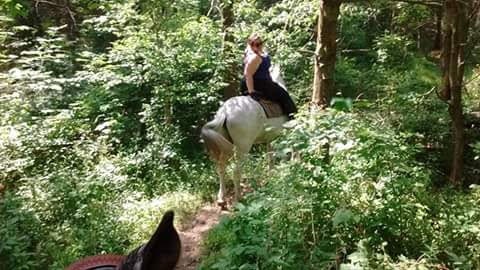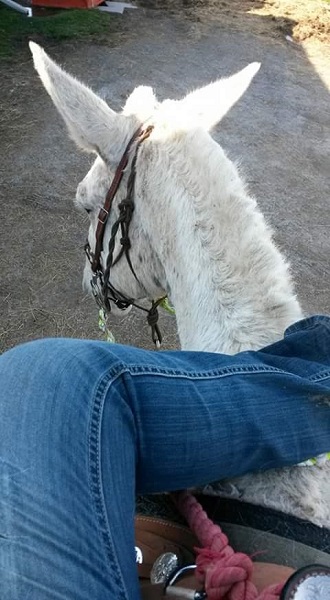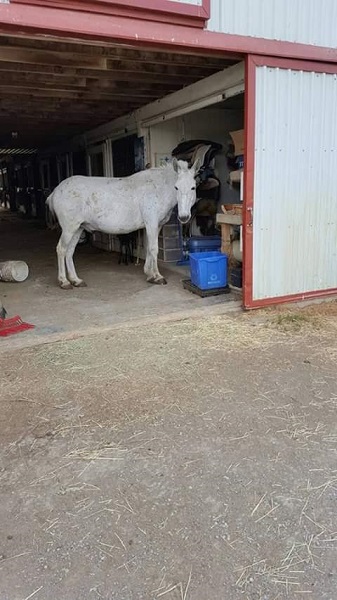Michele gave us one of our most popular Mule Tales two months ago with the touching story of her elderly lesson mule, Jillybean. I was intrigued by the idea of an all mule lesson barn (we have explored a similar subject here, with Le continents des Mules), and I enjoyed talking to Michelle so much that I wanted to hear more about her work and her life with mules.
The result is this brilliant chronicle. It’s a long one, but Michele has a great way of telling a story and I assure you it is well worth the read. So put on the kettle, make yourself a cup of tea, and enjoy!

1. How did you get involved with mules?
When I lived in Colorado nearly 30 years ago, I worked on a ranch that had some packing mules. When we rode fence line, we took a mule with us to carry supplies. My boss was old school. We were cowboys. We rode horses. No ATVs, no 4x4s.
So I developed a real liking for mules as sometimes if a horse came up lame, or couldn’t get to an area where the cattle went to hide … you saddled up your pack mule and did the job.
I was hooked ever since.
When I moved up here to Ontario, Canada, there were no mules to be found. I stayed with horses until purchasing my Mammoth Jackstock and broodmares. Now I’m doing mules full time. Unfortunately the first Jack I bred to was sterile … so no babies this year. I purchased a high quality show Jack yearling. We will be breeding him spring of 2017. His name is Royal Major League. His Father was the Legendary Jarrats Desert Prince.

2. What gave you the idea to set up an all mule riding program? Who was your first school mule?
I think it started the day my weekend helper girl asked if she could ride my personal mule, Blueberry Martini. So I guess that day Blueberry, affectionately known as Boopsie, not only gave me the idea of an all mule riding program – she also became my first lesson mule.
Giving a lesson to Kenzie on Blueberry allowed me to see how much difference there is in both the teaching and learning between using horses and mules. My 3 lesson horses are point and shoot schoolmasters. They take care of their rides and can basically do the job themselves while making sure their rider is doing ok.
Boopsie was a whole other story! She questioned every request Kenzie asked for. This process made Kenzie very aware of what she was doing, how she was doing it, and WHY she was doing it.
When I saw all the communication process going on between us … teacher and rider and mule … I realized that by using mules, the student had to become a rider rather than a passenger. The student had to use the skills they had been learning from me more accurately and precisely because the animal they were on was actually making them think.
Another reason for my choice of all mules in my program was the fact that I actually felt that my riders were safer on a good, surefooted mule than a horse that would just willingly do something without reasoning the safety and purpose of it first.
So Blue was my first real lesson mule. Prior to Blueberry, I had a client mule in for a tune up. I had put a few students up on him just for fun so they could try something new. I would say that about 90% of my students now would rather ride the mules instead of a horse.

3. How many mules do you currently have in the lesson program, and how do you match the right mule to the right rider?
I have four mules in my program right now. Jillybean and her brother Bill: they are Halflinger pony mules . I purchased Bill for his show record and his long record for being a children’s mule for both riding and driving. Jilly came in the package. She is my main leadline mule and therapy mule.
My third mule is my personal molly, Blueberry. She is my “moving up” mule. For the kids who are ready to move up into an intermediate program of riding. Also for adults ready to move to an intermediate to advanced level. She is 15.3 hands and still growing at 5-years-old.
My fourth mule is a Percheron Draft mule. His name is Kentucky Moonshine. He is 19-years-old and does everything from beginner to advanced lessons as he has the perfect temperament for all ages. His training is extensive in both English and Western which makes him wonderful for riders who want to move up into showing.
Matching rider to mule is an interesting process. With Bill and Jill, anyone who can sit in a saddle can ride them. But I let the children and the mules pick each other. Our very first lesson is always a “meet and greet”. The rider is introduced to Bill and Jill in the arena. Both mules are at liberty and the rider gets to interact with them while closely supervised. I find the rider will gravitate to the mule that suits them. Bill is more outgoing and attention seeking. Jill is quiet and introspective. Children who are quiet and shy seem to identify with Jill and bond with her quickly. Bill attracts the attention of the eager and gregarious children. He makes friends with his riders quickly and takes charge.
With Blueberry, I know I have to be the big decision maker in who rides her. Although she is very social even with total strangers, she is young and very willing. This makes her a people pleaser and too easily taken advantage of. So I make sure that the rider I pair her with is aware of their own limitations and experience. An over confident intermediate rider can be tempted to go beyond what their limits actually are and end up in a bad position by asking too much of Blueberry.
This is where Moonshine comes in. At 19-years-old (which is only middle age for a mule), Moonie has the experience and knowledge to allow him to take control of a situation with an over eager rider. If you think you are all ready to go “Hi Hi Silver! awayyyyy…” and try to get Moonie to gallop off into the sunset, when actually you are just ready enough for a controlled lope in the arena … Moonie will shut you down right there and say, “Sorry, Bubba … we are just gonna trot right now until you settle down.”
I have ridden him bareback with a halter and lead rope on an emergency search and rescue situation. He will do that for the right rider. But I have also seen him with his owner as he refused to canter until he felt she was ready and asking him properly. I kick myself for not buying Moonie when I had the chance. Luckily his wonderful owner, Miriam, allows me the privilege of using him in my riding program. He is the epitome of the perfect mule.

4. I have to ask – what was the emergency search and rescue situation, and what prompted you to choose a mule as your rescue vehicle?
Our emergency S&A was the result of some tourists getting lost in a large provincial park across the road from my farm.
Early on a Saturday morning in June, my weekend work student brought my attention to a large group of people milling around a small 3 way intersection. There were several vehicles, so I thought there was an accident.
I took my cell phone and hopped on Moonshine, who had his halter and lead rope on to be be taken to his pasture. It’s just kind of a habit from working on big ranches out in Colorado. If it’s too far to the truck … grab the first available horse.
Upon arrival at the intersection, Moonie and I were surround by roughly 20 Asian tourists with big smiles and the word, “Cowboy!” Ringing out.
The tour guide came forward to let me they were lost and trying to find an entry to the park. After a few minutes, we got their vans parked and the hikers on their way with maps.
I went back to chores and put the situation out of my mind.
Around 5pm, one of the tourist vans pulled into my driveway. The driver had gotten a call from the tour guide. He and his merry band of tourists were lost. I took the phone, asked for landmarks and looked at my watch. It was about 2 hours to sunset and the hikers had been gone for 7 hours.
The landmarks told me they had not stayed on the marked trails and had gone out of the park boundaries. The only clear landmark that gave me any idea where they were was the mention of giant cement chutes coming down a cliff. Luckily that narrowed their location to a specific area. Unluckily, that didn’t give me much time to find them.
So good old Moon and I set off through 2000 acres to find the lost tourists. And once again I hopped on him with just a halter and a lead rope.
The wonderful thing about a great mule … they will and can go places a horse won’t and can’t.
We left the known trail and headed straight south west. It could’ve been faster … but Moonie wasn’t a fast kind of mule. And you know the saying, “Slow and steady wins the race.”
Just as the sun was going down, we were able to find the hikers. They were only a few hundred yards from a main road. We got them out to the road and waited with them while the vans were called and given directions to come get their wayward passengers.
Moonshine took me home through miles of trails in dark. I never had to direct him on how to get home. I trusted him. I had faith in him.
We rode up my driveway close to 9pm under the bright light of a nearly full moon. Safe and sound.
Moonie got an extra helping of carrots that night.

5. What are your plans for Major League Mules in the future? What are you hoping to see from the mules that you breed?
2017 will be the first year of standing our registered spotted Mammoth Jack at stud to the public. He is the only registered spotted Mammoth Jack in Canada as far as we know.
It will also be the first year the All Mule Show Team will be making their debut.
And currently we have opened our doors to volunteer out mules and donkeys as therapy animals. We do this for free to give back to our community.
So along with invitations to be a guest clinician at Arizona Mule Days and the first female trainer at the American Mule Trainers Challenge in New Mexico, we have a super busy year ahead of us!
If you would like your mule to be featured here, or if you work with mules and would like to share your story, then please contact me either via this blog, message me on my Mulography Facebook page, or email me at: herecirm (at) gmail.com. I would particularly like to hear from UK mule owners (purely because Mulography is about owning a mule in the UK), but am happy to take worldwide submissions!
